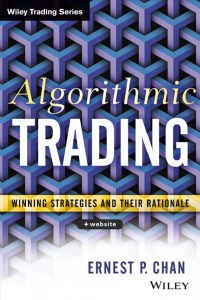Learn Algorithmic Trading
Learn Algorithmic Trading, Build and deploy algorithmic trading systems and strategies using Python and advanced data analysis by Sebastien Donadio, Sourav Ghosh.
Đặt in thành sách tại HoaXanh, xem sách in mẩu trong video bên dưới.
- 155,000đ
- Mã sản phẩm: LE1950
- Tình trạng: 2
Chapter 1: Algorithmic Trading Fundamentals 7
Why are we trading? 8
Basic concepts regarding the modern trading setup 8
Market sectors 9
Asset classes 10
Basics of what a modern trading exchange looks like 12
Understanding algorithmic trading concepts 13
Exchange order book 14
Exchange matching algorithm 14
FIFO matching 15
Pro-rata matching 15
Limit order book 16
Exchange market data protocols 16
Market data feed handlers 17
Order types 17
IOC – Immediate Or Cancel 17
GTD – Good Till Day 17
Stop orders 17
Exchange order entry protocols 18
Order entry gateway 18
Positions and profit and loss (PnL) management 18
From intuition to algorithmic trading 19
Why do we need to automate trading? 19
Evolution of algorithmic trading – from rule-based to AI 20
Components of an algorithmic trading system 22
Market data subscription 23
Limit order books 23
Signals 24
Signal aggregators 24
Execution logic 24
Position and PnL management 25
Risk management 26
Backtesting 26
Why Python? 27
Choice of IDE – Pycharm or Notebook 28
Section 2: Trading Signal Generation and Strategies
Chapter 2: Deciphering the Markets with Technical Analysis 39
Designing a trading strategy based on trend- and momentum-based
indicators 40
Support and resistance indicators 40
Creating trading signals based on fundamental technical analysis 47
Simple moving average 47
Implementation of the simple moving average 48
Exponential moving average 49
Implementation of the exponential moving average 51
Absolute price oscillator 53
Implementation of the absolute price oscillator 53
Moving average convergence divergence 55
Implementation of the moving average convergence divergence 56
Bollinger bands 59
Implementation of Bollinger bands 60
Relative strength indicator 62
Implementation of the relative strength indicator 63
Standard deviation 66
Implementing standard derivatives 66
Momentum 68
Implementation of momentum 69
Implementing advanced concepts, such as seasonality, in trading
instruments 71
Summary 79
Chapter 3: Predicting the Markets with Basic Machine Learning 80
Understanding the terminology and notations 81
Exploring our financial dataset 84
Creating predictive models using linear regression methods 87
Ordinary Least Squares 87
Regularization and shrinkage – LASSO and Ridge regression 93
Decision tree regression 94
Creating predictive models using linear classification methods 95
K-nearest neighbors 95
Support vector machine 98
Section 3: Algorithmic Trading Strategies
Chapter 4: Classical Trading Strategies Driven by Human Intuition 102
Creating a trading strategy based on momentum and trend
following 103
Examples of momentum strategies 104
Python implementation 104
Dual moving average 104
Naive trading strategy 107
Turtle strategy 109
Creating a trading strategy that works for markets with reversion
behavior 111
Examples of reversion strategies 112
Creating trading strategies that operate on linearly correlated
groups of trading instruments 112
Summary 130
Chapter 5: Sophisticated Algorithmic Strategies 131
Creating a trading strategy that adjusts for trading instrument
volatility 132
Adjusting for trading instrument volatility in technical indicators 132
Adjusting for trading instrument volatility in trading strategies 133
Volatility adjusted mean reversion trading strategies 134
Mean reversion strategy using the absolute price oscillator trading signal 134
Mean reversion strategy that dynamically adjusts for changing volatility 144
Trend-following strategy using absolute price oscillator trading signal 148
Trend-following strategy that dynamically adjusts for changing volatility 153
Creating a trading strategy for economic events 155
Economic releases 156
Economic release format 157
Electronic economic release services 157
Economic releases in trading 158
Understanding and implementing basic statistical arbitrage trading
strategies 161
Basics of StatArb 161
Lead-lag in StatArb 162
Adjusting portfolio composition and relationships 162
Infrastructure expenses in StatArb 163
StatArb trading strategy in Python 164
StatArb data set 164
Defining StatArb signal parameters 166
Defining StatArb trading parameters 167
Quantifying and computing StatArb trading signals 168
StatArb execution logic 172



